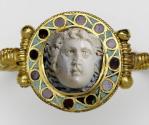Advanced Search
Early Byzantine bracelet with a Roman cameo of Medusa
Byzantine
Early Byzantine Period
5th century A.D., incorporating a cameo of the 1st-2nd centuries A.D.
Medium/Technique
Gold, chalcedony, garnet, and green glass paste (modern)
Dimensions
Overall: 4.1 x 7.3 cm (1 5/8 x 2 7/8 in.)
Credit Line
Gift of George D. and Margo Behrakis
Accession NumberAPP.2022.172
CollectionsEurope, Jewelry, Ancient Greece and Rome
ClassificationsJewelry / Adornment – Bracelets and armlets
DescriptionGold bracelet with a Roman cameo (1st–2nd century A.D.) of Medusa.
The style (taste for polychromy--inlaid colored stone and glass) and the reuse of an ancient cameo) and technique (tripartite hinge and screw pin) of manufacture resembles jewelry produced by tribes (e.g. Vandals, Huns, Alans, Goths) along the borders of the Byzantine empire.
The reverse side of the bezel encasing the cameo is decorated with a gold foil design of four palm leaves encircling a curved square surrounding a rosette. This decorative device is very close to one found on a pendant from the Olbia Treasure in South Russia (today Ukraine).
The style (taste for polychromy--inlaid colored stone and glass) and the reuse of an ancient cameo) and technique (tripartite hinge and screw pin) of manufacture resembles jewelry produced by tribes (e.g. Vandals, Huns, Alans, Goths) along the borders of the Byzantine empire.
The reverse side of the bezel encasing the cameo is decorated with a gold foil design of four palm leaves encircling a curved square surrounding a rosette. This decorative device is very close to one found on a pendant from the Olbia Treasure in South Russia (today Ukraine).
ProvenanceBy 2007, Theodore Sarmas (b. 1938 – d. 2018), London; 2008, sold by Theodore Sarmas, through Robert Haber and Associates, New York, to George and Margo Behrakis, Tewksbury, MA; 2022, gift of George and Margo Behrakis to the MFA. (Accession Date: June 22, 2022)
ADDITIONAL INFORMATION:
In 2008, this bracelet was purchased with the guidance of the Museum. The owner, Theodore Sarmas, provided documentation to the MFA that lists “a bracelet” along with trays, brooches, belts, crosses, and “other various items” that his father had acquired in 1937 from a Liverpool collector, Mr. Barry, and that were passed along to Mr. Sarmas at his father’s death in 1963. With this documentation, the MFA accepted the bracelet as a promised gift.
New information has come to light, suggesting that this was a false provenance used repeatedly by the seller. The story may have been fabricated to disguise a recent instance of archaeological looting. Normally, the MFA would not accept or hold an object believed to have been illicitly excavated without reaching out to representatives of the country of origin. In this case, however, the bracelet’s country of origin is not known. By drawing attention to its lack of provenance, the MFA hopes to increase the visibility of the bracelet, raise awareness of the problem of unprovenanced antiquities on the market, and bring in additional information from others.
ADDITIONAL INFORMATION:
In 2008, this bracelet was purchased with the guidance of the Museum. The owner, Theodore Sarmas, provided documentation to the MFA that lists “a bracelet” along with trays, brooches, belts, crosses, and “other various items” that his father had acquired in 1937 from a Liverpool collector, Mr. Barry, and that were passed along to Mr. Sarmas at his father’s death in 1963. With this documentation, the MFA accepted the bracelet as a promised gift.
New information has come to light, suggesting that this was a false provenance used repeatedly by the seller. The story may have been fabricated to disguise a recent instance of archaeological looting. Normally, the MFA would not accept or hold an object believed to have been illicitly excavated without reaching out to representatives of the country of origin. In this case, however, the bracelet’s country of origin is not known. By drawing attention to its lack of provenance, the MFA hopes to increase the visibility of the bracelet, raise awareness of the problem of unprovenanced antiquities on the market, and bring in additional information from others.




